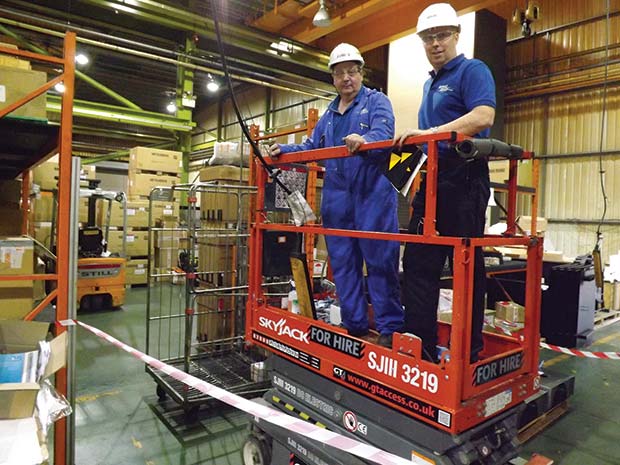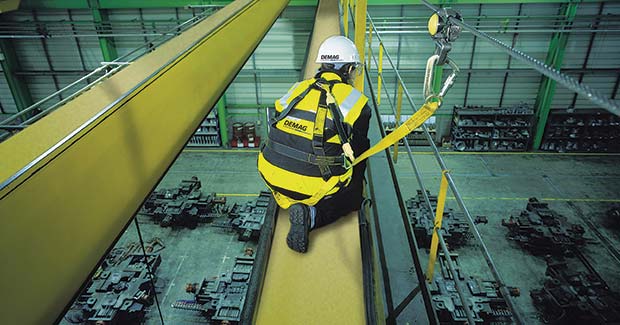Gordon Baird is Services’ Director at Terex Material Handling, with responsibility for the company’s UK aftersales business, which includes the maintenance, repair, overhaul and refurbishment of Demag crane systems and the lifting gear of other manufacturers. He is also responsible for the safety and welfare of over 50 UK field service technicians. Gordon examines the hazards of working at height and the measures which should be employed to minimise risks.
 Falls from height are the biggest single cause of death in the workplace and one of the biggest causes of serious injury. In 2013/14, there were 19 fatalities and 2895 serious injuries, resulting from falls from height. There have been improvements in workplace safety over the last decade and last year’s figures compare favourably with the 53 deaths and 3804 serious injuries, recorded in 2003/04. However, we must all work harder to minimise the hazards of working at height and reduce the number of casualties.
Falls from height are the biggest single cause of death in the workplace and one of the biggest causes of serious injury. In 2013/14, there were 19 fatalities and 2895 serious injuries, resulting from falls from height. There have been improvements in workplace safety over the last decade and last year’s figures compare favourably with the 53 deaths and 3804 serious injuries, recorded in 2003/04. However, we must all work harder to minimise the hazards of working at height and reduce the number of casualties.
A duty of care for employers
Under the Work at Height Regulations 2005, employers have a duty of care to employees, contractors and third parties. Those in control of any working at height must make sure work is properly planned, supervised and carried out by competent operators. Training and suitable equipment should also be provided. The regulations state that work at height should be avoided where it is reasonably practicable to do so. Where such work cannot be easily avoided, measures should be taken to prevent falls by using an existing safe place of work or by employing suitable safety equipment. They also state that the distance and consequence of a potential fall should be minimised where the risk cannot be eliminated. Failure to comply with the Work at Height Regulations can be severe with penalties of unlimited fines and up to two year prison sentences.
Safe access to working at height platforms
Even the process of gaining access to working at height platforms can create the risk of a fall. The preferred means of access to crane girders and high structures should be mobile elevated work platforms, such as scissor lifts or cherry pickers. Before operating access equipment, operators should conduct a thorough examination, checking general wear and tear, power levels, tyre damage, tyre pressures, potential leaks from hydraulic lines and system stability. In the event of any defect, technicians should challenge line managers to rectify the fault and carry out a full inspection to certify that the equipment is safe for use.

Fall protection systems
At Terex Material Handling, we issue personal protection equipment, including safety harnesses and lanyards, to all service technicians as part of their induction. The use of this equipment is compulsory during all work at height. As part of our health and safety regimes, all technicians’ equipment is checked annually.
There are a number of fall arrest systems available, which significantly enhance safety whilst working at height. Latchways offers a comprehensive range of fall protection systems, including the innovative ManSafe®, developed for industrial applications. ManSafe® affords operators unfettered movement and continuous, hands free security whilst working at height. The operator’s safety harness is secured to the ManSafe® safety line via a high integrity lanyard and a ‘transfastener’ mobile anchor point, providing comfort and mobility for the operator. As a registered specifier, supplier and installer of these products, Terex Material Handling is offering Latchways’ fall protection systems for new installations, retrofits and refurbishments of Demag equipment, as well other manufacturers’ cranes.

Training is fundamental for a safe working environment
Providing product familiarisation and training to operators are key factors in ensuring safe working at height procedures. All companies responsible for employees working at height should have detailed and thorough procedures in place to protect against industrial falls. Our technicians receive internal induction training on working at height, followed up by annual refresher courses. The courses include instruction on the use of harnesses and lanyards, as well as associated fall protection systems. They also receive external IPAF training on the use of mobile elevated work platforms. The thoroughness of our training and our commitment to health and safety best practice have, in part, contributed to our enviable record of zero working at height injuries in recent years.
The future of working at height
There will always be situations where operators are required to work at height and it is incumbent upon everyone in the industry to take all possible measures to reduce the number of accidents. The Health and Safety Executive will continue to review, monitor and update the appropriate regulations, whilst safety equipment manufacturers will develop new and improved fall protection systems.
There is also increased awareness, regarding the importance of the prompt rescue and retrieval of an individual who has fallen from height but is suspended by the harness. This is a critical issue as such a situation may cause suspension trauma, which can set in within 20 minutes and is potentially fatal.
Tel: 01295 676100




Comments are closed.